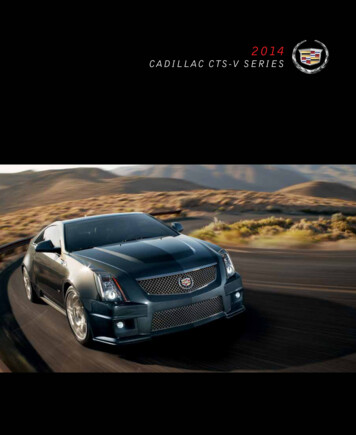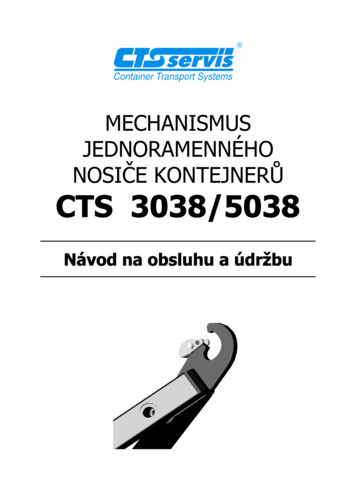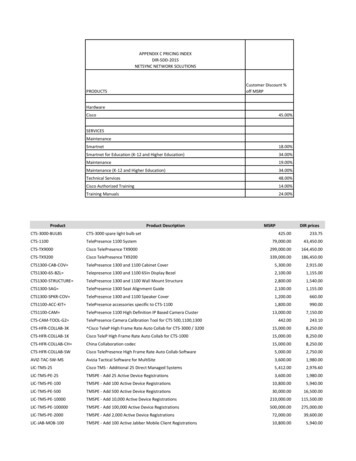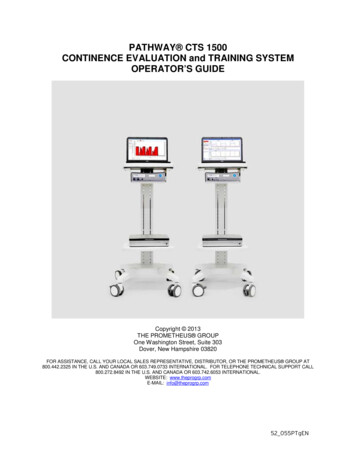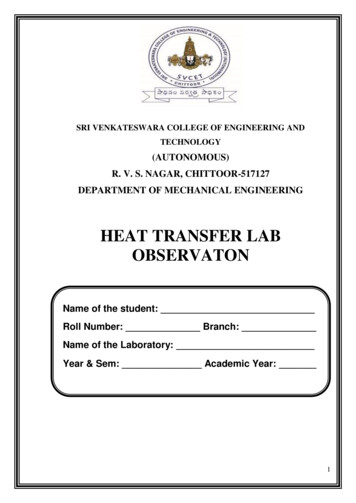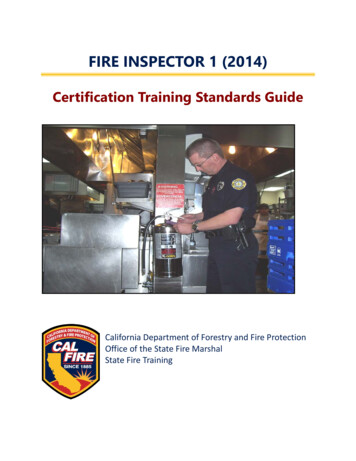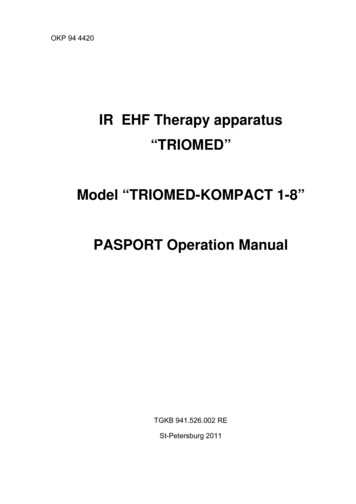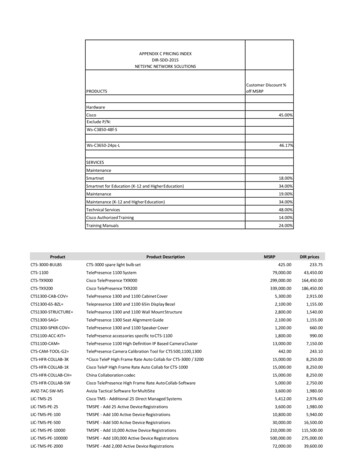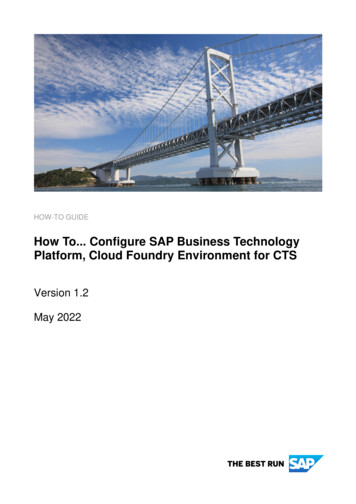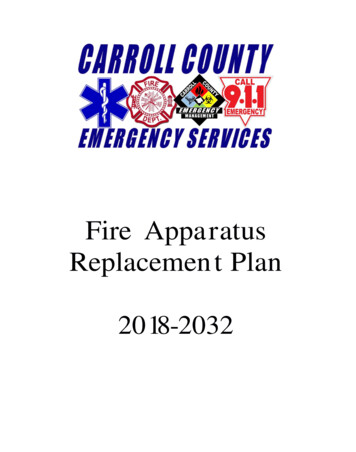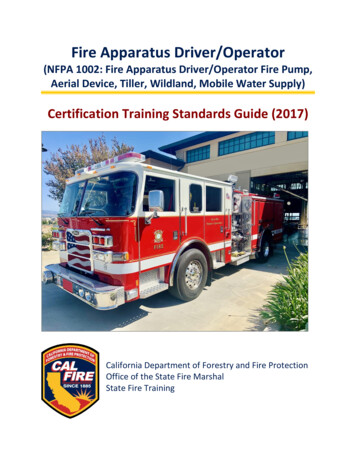
Transcription
Fire Apparatus Driver/Operator(NFPA 1002: Fire Apparatus Driver/Operator Fire Pump,Aerial Device, Tiller, Wildland, Mobile Water Supply)Certification Training Standards Guide (2017)California Department of Forestry and Fire ProtectionOffice of the State Fire MarshalState Fire Training
Fire Apparatus Driver/OperatorCertification Training Standards Guide (2017)Publication Date: August 2021This CTS guide utilizes the following NFPA standards to provide the qualifications for State FireTraining’s Standard for Fire Apparatus Driver/Operator (2017) certification: NFPA 1002: Standard for Fire Apparatus Driver/Operator Professional Qualifications(2017)State Fire Training coordinated the development of this CTS guide. Before its publication, theStatewide Training and Education Advisory Committee (STEAC) and the State Board of FireServices (SBFS) recommended this CTS guide for adoption by the Office of the State FireMarshal (OSFM).Cover photo courtesy of Alameda County Fire Department.Published by State Fire Training.
Table of ContentsTable of ContentsAcknowledgements. 1How to Read a CTS Guide . 2Fire Apparatus. 4Section 1: Preventative Maintenance. 41-1: Perform Visual and Operational Checks. 41-2: Document Visual and Operational Checks . 6Section 2: Operations. 72-1: Operate a Fire Apparatus . 72-2: Back a Fire Apparatus from a Roadway into a Restricted Space. 92-3: Maneuver a Fire Apparatus around Obstructions. 112-4: Turn a Fire Apparatus 180 Degrees within a Confined Space . 132-5: Maneuver a Fire Apparatus in Areas with Restricted Clearances . 142-6: Operate All Fixed Systems and Equipment on a Fire Apparatus. 16Section 3: Fire Department Communications . 173-1: Initiate the Response to a Reported Emergency. 173-2: Receive a Telephone Call . 183-3: Transmit and Receive Radio Messages . 193-4: Activate Emergency Procedures. 20Pumping Apparatus . 21Section 4: Preventative Maintenance. 214-1: Fire Pump Driver/Operator Roles and Responsibilities. 214-2: Perform and Document Visual and Operational Checks. 22Section 5: Operations. 245-1: Respond on an Apparatus to an Emergency Scene. 245-2: Establish and Operate at Emergency and Nonemergency Scenes. 255-3: Connect to a Water Supply. 265-4: Produce Effective Hand Lines and Master Streams . 275-5: Pump a Supply Line. 295-6: Produce a Foam Fire Steam. 315-7: Supply Water to Fire Sprinkler and Standpipe Systems. 32Aerial Apparatus . 34Section 6: Preventative Maintenance. 346-1: Perform and Document Visual and Operational Checks. 34Section 7: Operations. 367-1: Maneuver and Position an Aerial Apparatus. 367-2: Stabilize an Aerial Apparatus. 377-3: Maneuver and Position an Aerial Device from Each Control Station. 387-4: Lower an Aerial Using the Emergency Operating System. 407-5: Deploy and Operate an Elevated Master Stream. 42
Table of ContentsTillered Apparatus. 43Section 8: Preventative Maintenance. 438-1: Perform and Document Visual and Operational Checks. 43Section 9: Operations. 449-1: Perform Practical Driving Exercises . 449-2: Operate a Tillered Apparatus . 469-3: Position and Stabilize a Tillered Apparatus . 48Wildland Fire Apparatus . 49Section 10: Preventative Maintenance. 4910-1: Perform and Document Visual and Operational Checks. 49Section 11: Operations. 5111-1: Operate a Wildland Fire Apparatus. 5111-2: Produce Effective Fire Streams. 5311-3: Pump a Supply Line. 5511-4: Produce a Foam Fire Stream . 57Water Tender. 58Section 12: Preventative Maintenance. 5812-1: Perform and Document Visual and Operational Checks. 58Section 13: Operations. 6013-1: Operate a Water Tender. 6013-2: Maneuver and Position a Water Tender at a Water Shuttle Fill Site . 6213-3: Maneuver and Position a Water Tender at a Water Shuttle Dumpsite. 6413-4: Establish a Water Shuttle Dumpsite. 65
AcknowledgmentsAcknowledgementsState Fire Training appreciates the hard work and accomplishments of those who build the solidfoundation on which this program continues to grow.State Fire Training gratefully acknowledges the following individuals and organizations for theirdiligent efforts and contributions that made the development and publication of this documentpossible.CAL FIRE Thom Porter, DirectorMike Richwine, State Fire MarshalAndrew Henning, Assistant Deputy DirectorJohn Binaski, Chair, Statewide Training and Education Advisory Committee (STEAC);Chief, Clovis Fire DepartmentCadre – 2021 UpdateLeadership Chris Fowler, Cadre Lead, Deputy State Fire Marshall III, Supervisor, State Fire TrainingCaryn Petty, Cadre Lead, Deputy State Fire Marshal III, Regional Coordinator, State FireTrainingAllison L. Shaw, Editor, California State University, SacramentoMembers Garrett Huff, Battalion Chief, Santa Barbara County Fire DepartmentAaron Panfilio, Captain, Alameda County Fire DepartmentMatt McDonald, Captain, CAL FIRE Riverside UnitAnthony Stornetta, Battalion Chief, Santa Barbara County Fire DepartmentPublished August 2021Page 1 of 65
How to Read a CTS GuideHow to Read a CTS GuideOverviewA certification training standard (CTS) guide lists the requisite knowledge, skills, and jobperformance requirements an individual must complete in order to become certified in aspecific job function.It also documents and justifies the OSFM-approved revisions to the certification’s NFPAstandard, and identifies where each certification training standard is taught (course plan),tested (skill sheets), and validated (task book).Individuals aspiring to meet State Fire Training’s certification training standards must do so inaccordance with the codes, standards, regulations, policies, and standard operating proceduresapplicable within their own agency or jurisdiction.FormatEach certification training standard is comprised of eight sections.Section HeadingTraining standards are grouped by section headings that describe a general category. Forexample, the Fire Fighter 1 CTS guide includes the following section headings: NFPARequirements, Fire Department Communications, Fireground Operations, and Preparednessand Maintenance.Training Standard TitleThe training standard title provides a general description of the performance requirementcontained within the individual standard.AuthorityThe CTS guide references each individual standard with one or more paragraphs of thecorresponding National Fire Protection Association (NFPA) Professional Qualifications. Thisensures that each fire service function within California's certification system meets or exceedsNFPA standards.When California requirements exceed the NFPA standard, the CTS guide cites the Office of theState Fire Marshal as the authority and prints the corresponding information in italics.Job Performance RequirementsThis segment includes a written statement that describes a specific job-related task, the itemsan individual needs to complete the task, and measurable or observable outcomes.Published August 2021Page 2 of 65
How to Read a CTS GuideRequisite KnowledgeThis segment lists the knowledge that an individual must acquire in order to accomplish the jobperformance requirement.Requisite SkillsThis segment lists the skills that an individual must acquire in order to accomplish the jobperformance requirement.Content ModificationThis table documents and justifies any revisions to the NFPA standard that the development orvalidation cadres make during the development of a CTS guide.Cross ReferenceThis table documents where each training standard is taught (course plan), tested (skill sheets),and validated (task book).Published August 2021Page 3 of 65
Fire ApparatusSection 1: Preventative MaintenanceFire ApparatusSection 1: Preventative Maintenance1-1: Perform Visual and Operational ChecksAuthority1. NFPA 1002: Standard for Fire Apparatus Driver/Operator Professional Qualifications (2017) Paragraph 4.2.1Job Performance RequirementPerform visual and operational checks on the systems and components specified in thefollowing list (battery(ies), braking system, coolant system, electrical system, fuel, hydraulicfluids, oil, tires, steering system, belts, tools, appliances, equipment, built-in safety features),given a fire apparatus, its manufacturer’s specifications, tools and equipment, and policies andprocedures of the jurisdiction, so that the operational status of the vehicle is verified.Requisite Knowledge1. Identify manufacturer specifications and requirements2. Identify policies and procedures of the jurisdictionRequisite Skills1. Use tools and equipment2. Recognize system problems and out-of-service criteria3. Correct any deficiency noted according to policies and procedures and/or manufacturerspecifications and requirementsContent es “fire department vehicle” to None given. (2014)“fire apparatus”.JPRAdded “tools and equipment”.Required to perform operational checks.(2014)RS1Added “and equipment”.Required to perform operational checks.(2014)RS2Added “and out-of-service criteria”.None given. (2014)RS3Added “and/or manufacturerNone given. (2014)specifications and requirements”.Published August 2021Page 4 of 65
Fire ApparatusSection 1: Preventative MaintenanceCross ReferenceCourse PlanFire Apparatus Driver/Operator 1A:Fire Apparatus Driver/Operator Topic 2-1Skill SheetsN/APublished August 2021Task BookPumping Apparatus Driver/Operator JPR 1Aerial Apparatus Driver/Operator JPR 1Tillered Apparatus Driver/Operator JPR1Wildland Fire Apparatus Driver/Operator JPR1Water Tender Driver/Operator JPR 1Page 5 of 65
Fire ApparatusSection 1: Preventative Maintenance1-2: Document Visual and Operational ChecksAuthority1. NFPA 1002: Standard for Fire Apparatus Driver/Operator Professional Qualifications (2017) Paragraph 4.2.2Job Performance RequirementDocument visual and operational checks, given maintenance and inspection forms, so that allitems are checked for operation and deficiencies are reported.Requisite Knowledge1. Identify AHJ requirements for documenting maintenance performed2. Describe the importance of keeping accurate recordsRequisite Skills1. Use tools and equipment2. Complete all related AHJ formsContent ModificationBlockRK1RS2ModificationChanged “departmental” to “AHJ”.Changed “departmental” to “AHJ”.Cross ReferenceCourse PlanFire Apparatus Driver/Operator 1A:Fire Apparatus Driver/Operator Topic 2-2Skill SheetsN/APublished August 2021JustificationNone given. (2014)None given. (2014)Task BookPumping Apparatus Driver/Operator JPR 2Aerial Apparatus Driver/Operator JPR 2Tillered Apparatus Driver/Operator JPR 2Wildland Fire Apparatus Driver/Operator JPR 2Water Tender Driver/Operator JPR 2Page 6 of 65
Fire ApparatusSection 2: OperationsSection 2: Operations2-1: Operate a Fire ApparatusAuthority1. NFPA 1002: Standard for Fire Apparatus Driver/Operator Professional Qualifications (2017) Paragraph 4.3.1 Paragraph 4.3.6Job Performance RequirementOperate a fire apparatus during emergency and non-emergency responses using defensivedriving techniques, given an apparatus, an assignment, a predetermined route on a public waythat incorporates the maneuvers and features that the driver/operator is expected toencounter during normal operations, and AHJ policies and procedures, so that control of theapparatus is maintained and the apparatus is operated in compliance with all applicable stateand local laws and AHJ rules and regulations.Requisite Knowledge1. Describe the importance of donning passenger restraint devices and ensuring crew safety2. Identify common causes of fire apparatus accidents3. Recognize that fire apparatus driver/operators are responsible for the safe and prudentoperation of the apparatus under all conditions4. Describe the effects of liquid surge, braking reaction time, and load factors on apparatuscontrol5. Describe the effects of high center of gravity on rollover potential, general steeringreactions, speed, and centrifugal force6. Identify applicable laws and regulations7. Describe principles of skid avoidance, night driving, shifting, and gear patterns8. Describe how to apply automatic braking systems in wet and dry conditions9. Describe how to negotiate intersections, railroad crossings, and bridges10. Identify weight and height limitations for both roads and bridges11. Describe how to identify and operate automotive gauges12. Identify operational limits of different types of fire apparatusRequisite Skills1. Operate passenger restraint devices2. Maintain safe following distances3. Maintain control of the apparatus while accelerating, decelerating, and turning, given road,weather, and traffic conditions4. Operate under adverse environmental or driving surface conditions5. Use automotive gauges and controlsPublished August 2021Page 7 of 65
Fire ApparatusSection 2: OperationsContent dificationChanged “vehicle” to “apparatus”.Changed “departmental” to “AHJ”.Added “during emergency and nonemergency responses.Added “and AHJ policies andprocedures”.Changed word order.Added “/operators”.Changed “vehicle” to “apparatus”.Changed “vehicle” to “apparatus”.Added “of different types of fireapparatus”.Changed “vehicle” to “apparatus”.Cross ReferenceCourse PlanFire Apparatus Driver/Operator 1A:Fire Apparatus Driver/Operator Topic 3-1 Topic 3-2None given. (2014)Word order changed for grammarconsistency. (2014)Added to match certification role. (2014)Changed for consistency. (2014)Changed for consistency. (2014)Added to narrow scope of learningobjective. (2014)Changed for consistency. (2014)Skill SheetsN/APublished August 2021JustificationChanged for consistency. (2014)Changed for consistency. (2014)None given. (2014)Task BookPumping Apparatus Driver/Operator JPR 3Aerial Apparatus Driver/Operator JPR 3Tillered Apparatus Driver/Operator JPR 3Wildland Fire Apparatus Driver/Operator JPR 3Water Tender Driver/Operator JPR 3Page 8 of 65
Fire ApparatusSection 2: Operations2-2: Back a Fire Apparatus from a Roadway into a Restricted SpaceAuthority1. NFPA 1002: Standard for Fire Apparatus Driver/Operator Professional Qualifications (2017) Paragraph 4.3.2Job Performance RequirementBack a fire apparatus from a roadway into restricted spaces on both the right and left sides ofthe apparatus, given a fire apparatus, a spotter where the spotter assists the driver inperforming the maneuver, and restricted spaces 12 ft (3.7 m) in width, requiring 90-degreeright-hand and left-hand turns from the roadway, so that the vehicle is parked within therestricted areas without have to stop and pull forward and without striking obstructions.Requisite Knowledge1.2.3.4.Identify fire apparatus dimensionsDescribe turning characteristicsDescribe spotter signalingDescribe principles of safe fire apparatus operationRequisite Skills1. Use mirrors2. Judge fire apparatus clearanceContent ModificationBlockModificationJPRChanged “vehicle” to “fire apparatus” and“apparatus”.RK1Changed “vehicle” to “fire apparatus”.RK4Changed “vehicle” to “fire apparatus”.RS2Changed “vehicle” to “fire apparatus”.Cross ReferenceCourse PlanFire Apparatus Driver/Operator 1A:Fire Apparatus Driver/Operator Topic 3-3Skill SheetsN/APublished August 2021JustificationChanged for consistency. (2014)Changed for consistency. (2014)Changed for consistency. (2014)Changed for consistency. (2014)Task BookPumping Apparatus Driver/Operator JPR 4Aerial Apparatus Driver/Operator JPR 4Tillered Apparatus Driver/Operator JPR 4Wildland Fire Apparatus Driver/Operator JPR 4Water Tender Driver/OperatorPage 9 of 65
Fire ApparatusSection 2: Operations Published August 2021JPR 4Page 10 of 65
Fire ApparatusSection 2: Operations2-3: Maneuver a Fire Apparatus around ObstructionsAuthority1. NFPA 1002: Standard for Fire Apparatus Driver/Operator Professional Qualifications (2017) Paragraph 4.3.3Job Performance RequirementManeuver a fire apparatus around obstructions on a roadway while moving forward and inreverse, given a fire apparatus, a spotter where the spotter assists the driver in performing themaneuver, and a roadway with obstructions, so that the vehicle is maneuvered through theobstructions without stopping to change the direction of travel and without striking anyobstructions.Requisite Knowledge1.2.3.4.5.Identify fire apparatus dimensionsDescribe turning characteristicsDescribe the effects of liquid surgeDescribe spotter signalingDescribe principles of safe fire apparatus operationRequisite Skills1. Use mirrors2. Judge fire apparatus clearanceContent ModificationBlockJPRRK1RK5RS2ModificationChanged “vehicle” to “fire apparatus”.Changed “vehicle” to “fire apparatus”.Changed “vehicle” to “fire apparatus”.Changed “vehicle” to “fire apparatus”.Cross ReferenceCourse PlanFire Apparatus Driver/Operator 1A:Fire Apparatus Driver/Operator Topic 3-4Skill SheetsN/APublished August 2021JustificationChanged for consistency. (2014)Changed for consistency. (2014)Changed for consistency. (2014)Changed for consistency. (2014)Task BookPumping Apparatus Driver/Operator JPR 5Aerial Apparatus Driver/Operator JPR 5Tillered Apparatus Driver/Operator JPR 5Wildland Fire Apparatus Driver/Operator JPR 5Water Tender Driver/OperatorPage 11 of 65
Fire ApparatusSection 2: Operations Published August 2021JPR 5Page 12 of 65
Fire ApparatusSection 2: Operations2-4: Turn a Fire Apparatus 180 Degrees within a Confined SpaceAuthority1. NFPA 1002: Standard for Fire Apparatus Driver/Operator Professional Qualifications (2017) Paragraph 4.3.4Job Performance RequirementTurn a fire apparatus 180 degrees within a confined space, given a fire apparatus, a spotter forbacking up, and an area in which the apparatus cannot perform a U-turn without stopping andbacking up, so that the apparatus is turned 180 degrees without striking obstructions within thegiven space.Requisite Knowledge1.2.3.4.5.Identify fire apparatus dimensionsDescribe turning characteristicsDescribe the effects of liquid surgeDescribe spotter signalingDescribe principles of safe fire apparatus operationRequisite Skills1. Use mirrors2. Judge fire apparatus clearanceContent ModificationBlockJPRRK1RK5RS2ModificationChanged “vehicle” to “apparatus”.Changed “vehicle” to “apparatus”.Changed “vehicle” to “apparatus”.Changed “vehicle” to “apparatus”.JustificationChanged for consistency. (2014)Changed for consistency. (2014)Changed for consistency. (2014)Changed for consistency. (2014)Cross ReferenceCourse PlanSkill SheetsTask BookFire Apparatus Driver/Operation 1A:Pumping Apparatus Driver/OperatorFire Apparatus Driver/Operator JPR 6 Topic 3-1 (RK3)Aerial Apparatus Driver/Operator Topic 3-5 (RK1, RK2, RK4, JPR 6RK5, RS1, RS2)Tillered Apparatus Driver/OperatorN/A JPR 6Wildland Fire Apparatus Driver/Operator JPR 6Water Tender Driver/Operator JPR 6Published August 2021Page 13 of 65
Fire ApparatusSection 2: Operations2-5: Maneuver a Fire Apparatus in Areas with Restricted ClearancesAuthority1. NFPA 1002: Standard for Fire Apparatus Driver/Operator Professional Qualifications (2017) Paragraph 4.3.5Job Performance RequirementManeuver a fire apparatus in areas with restricted horizontal and vertical clearances, given afire apparatus and a course that requires the operator to move through areas of restrictedhorizontal and vertical clearances, so that the operator judges the ability of the apparatus topass through the openings, using continual motion, and so that no obstructions are struck.Requisite Knowledge1.2.3.4.5.Identify fire apparatus dimensionsDescribe turning characteristicsDescribe the effects of liquid surgeDescribe spotter signalingDescribe principles of safe fire apparatus operationRequisite Skills1. Use mirrors2. Judge fire apparatus clearanceContent ModificationBlockJPRJPRModificationChanged “vehicle” to “apparatus”.Added “using continual motion”.RK1RK5RS2Changed “vehicle” to “apparatus.”Changed “vehicle” to “apparatus.”Changed “vehicle” to “apparatus.”Published August 2021JustificationChanged for consistency. (2014)Cadre asserts that this is the original intent ofthe skill. This needs to be accomplishedwithout starting and stopping. Addition makesit consistent with all other JPRs in this chapter.(2021)Changed for consistency. (2014)Changed for consistency. (2014)Changed for consistency. (2014)Page 14 of 65
Fire ApparatusSection 2: OperationsCross ReferenceCourse PlanSkill SheetsTask BookFire Apparatus Driver/Operation 1A:Pumping Apparatus Driver/OperatorFire Apparatus Driver/Operator JPR 7 Topic 3-1 (RK3)Aerial Apparatus Driver/Operator Topic 3-6 (RK1, RK2, RK4, JPR 7RK5, RS1, RS2)Tillered Apparatus Driver/OperatorN/A JPR 7Wildland Fire Apparatus Driver/Operator JPR 7Water Tender Driver/Operator JPR 7Published August 2021Page 15 of 65
Fire ApparatusSection 2: Operations2-6: Operate All Fixed Systems and Equipment on a Fire ApparatusAuthority1. NFPA 1002: Standard for Fire Apparatus Driver/Operator Professional Qualifications (2017) Paragraph 4.3.7Job Performance RequirementOperate all fixed systems and equipment on a fire apparatus not addressed elsewhere in thisstandard, given fixed systems and equipment, manufacturer’s specifications and requirements,and AHJ policies and procedures for the systems and equipment, so that each system or pieceof equipment is operated in accordance with the applicable instructions and policies.Requisite Knowledge1. Describe manufacturer’s specifications and operating procedures2. Identify policies and procedures of the jurisdictionRequisite Skills1. Deploy, energize, and monitor the system or equipment2. Recognize and correct system problemsContent ModificationBlockJPRModificationReplaced “vehicle” with “fire apparatus”.JPRJPRAdded “fixed”.Replaced “and instructions” with “andrequirements”.Replaced “departmental” with “AHJ”.JPRJustificationReplaced for consistency.(2014)None given. (2014)None given. (2014)Replaced for consistency.(2014)Cross ReferenceCourse PlanSkill SheetsTask BookFire Apparatus Driver/Operation 1A:Pumping Apparatus Driver/OperatorFire Apparatus Driver/Operator JPR 8 Topic 3-7Aerial Apparatus Driver/Operator JPR 8Tillered Apparatus Driver/OperatorN/A JPR 8Wildland Fire Apparatus Driver/Operator JPR 8Water Tender Driver/Operator JPR 8Published August 2021Page 16 of 65
Fire ApparatusSection 3: Fire Department CommunicationsSection 3: Fire Department Communications3-1: Initiate the Response to a Reported EmergencyAuthority1. NFPA 1002: Standard for Fire Apparatus Driver/Operator Professional Qualifications (2017) Paragraph 4.4.1Job Performance RequirementInitiate the response to a reported emergency, given the report of an emergency, firedepartment SOPs, and communications equipment, so that all necessary information isobtained, communication equipment is operated correctly, and the information is relayedpromptly and accurately to the dispatch center. [1001:5.2.1]Requisite Knowledge1. Describe procedures for reporting an emergency2. Identify departmental SOPs for taking and receiving alarms, radio codes, or procedures3. Identify information needs of dispatch centerRequisite Skills1. Operate fire department communications equipment2. Relay information3. Record informationContent ModificationBlockCross ReferenceModificationCourse PlanTesting and validation for this standard is fulfilled through OSFMFire Fighter 1 certification.Published August 2021JustificationSkill SheetsTask BookN/AN/APage 17 of 65
Fire ApparatusSection 3: Fire Department Communications3-2: Receive a Telephone CallAuthority1. NFPA 1002: Standard for Fire Apparatus Driver/Operator Professional Qualifications (2017) Paragraph 4.4.2Job Performance RequirementReceive a telephone call, given a fire department phone, so that procedures for answering thephone are used and the caller’s information is relayed. [1001:5.2.2]Requisite Knowledge1. Describe fire department procedures for answering nonemergency telephone calls.Requisite Skills1. Operate fire station telephone and intercom equipmentContent ModificationBlockCross ReferenceModificationCourse PlanTesting and validation for this standard is fulfilled throughOSFM Fire Fighter 1 certification.Published August 2021JustificationSkill SheetsTask BookN/AN/APage 18 of 65
Fire ApparatusSection 3: Fire Department Communications3-3: Transmit and Receive Radio MessagesAuthority1. NFPA 1002: Standard for Fire Apparatus Driver/Operator Professional Qualifications (2017) Paragraph 4.4.3Job Performance RequirementTransmit and receive messages via the fire department radio, given a fire department radio andoperating procedures, so that the information is accurate, complete, clear, and relayed withinthe time established by the AHJ. [1001:5.2.3]Requisite Knowledge1. Describe departmental radio procedures and etiquette for routine traffic, emergency traffic,and emergency evaluation signalsRequisite Skills1. Operate radio equipment2. Discriminate between routine and emergency trafficContent ModificationBlockCross ReferenceModificationCourse PlanTesting and validation for this standard is fulfilled throughOSFM Fire Fighter 1 certification.Published August 2021JustificationSkill SheetsTask BookN/AN/APage 19 of 65
Fire ApparatusSection 3: Fire Department Communications3-4: Activate Emergency ProceduresAuthority1. NFPA 1002: Standard for Fire Apparatus Driver/Operator Professional Qualifications (2017) Paragraph 4.4.4Job Performance RequirementActivate emergency procedu
standard, and identifies where each certification training standard is taught (course plan), tested (skill sheets), and validated (task book). . Recognize that fire apparatus driver/operators are responsible for the safe and prudent operation of the apparatus under all conditions 4. Describe the effects of liquid surge, braking reaction time .
